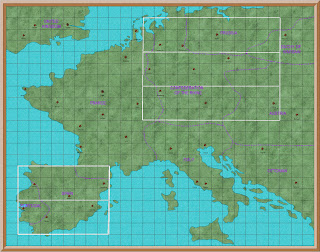23 March 1813 –
Northern Spain – Day 1
Both armies advance with orders to make contact with the
enemy, but avoid a battle
The Centre and north wing both halt as soon as they sight
the enemy
Wellington orders the southern wing to probe the town of
Arevalo
Soult orders his southern wing to react to the enemy
Battle of Arevalo – move 2
Both armies advance towards the town of Arevalo
Neither commander want to engage in a major battle
The eastern half of the town is held by 6th Spanish brigade
The British commander is determined to support them
The French will reach the Spanish held part of the town
first
The French commander takes command of two brigades from 7th
corps
With them he will attack and take the town
7th and 13th corps are ordered to
hold the north and south of the town
French artillery rout the Spanish garrison
The British commander takes command of one brigade from
each corps
He leads them into the town to prevent its capture by the
French
The battle is decided by the fight for the town.
Artillery on both sides support the attack, but have
little effect
At nightfall the French hold the town and win the battle
Town Fighting
The ground area of all built up areas is defined by 6x6”
squares of felt. One square represents a
village or farm, two squares a small town and four squares a city. Arevalo is one of three walled towns in this
campaign.
Only infantry can fight in built up areas, they move 4”
per turn which is half speed. As soon
as they enter the town the buildings are removed to allow skirmish and hand to
hand fighting, plus exact location of each brigade.
Two brigades are allowed in each town section. Only one can fight, the second is a
reserve. If the support it within 2”
they can replace the forward brigade.
It takes a full move and both are disorganised during that move.
When a brigade reaches the forward edge of the felt
square they have two options. They can
become a garrison, which takes a full move.
They then have advantage of cover and have an advantage is skirmish and
hand to hand fighting. Fighting for a
defended town section often ends in victory for the defender, unless the
attacker can attack with at least one more brigade outside the town.
Or the brigade can advance to engage in hand to hand
fighting. When the two brigades are
within 4” the one who moves first next move can charge and gain plus one on the
first melee for impetus. This hand to
hand fighting always results in casualties and usually does not last more than
one or two moves.
In this game the town fighting went on five moves. At the end of the first move the British
lost and routed. The reserve brigade
moved forward to replace them. The
French reserve took advantage of this lull to do the same. The
two reserve brigades then fought for four moves, each taking casualties each
move. Finally the British routed with
30% casualties and the French stood with 20% casualties.
During the fighting for the town the Spanish lost 1
casualty, the British 5 and the French also 5.
One French casualty was caused by artillery fire.
The rest of both armies just stood and watched. Both had orders to observe, and not to
engage in a major battle. Both probably
exceed their orders to risk so much in town fighting.
Very interesting game for town fighting, but did not put
the larger 6 corps armies to the test.








